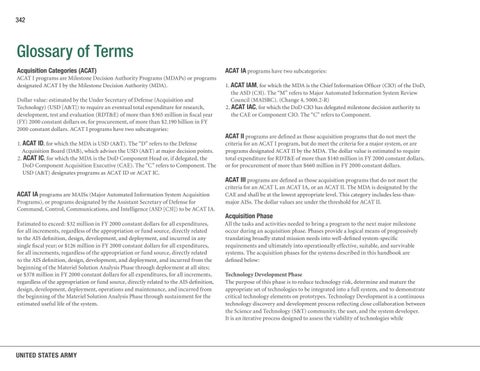342
Glossary of Terms Acquisition Categories (ACAT) ACAT I programs are Milestone Decision Authority Programs (MDAPs) or programs designated ACAT I by the Milestone Decision Authority (MDA). Dollar value: estimated by the Under Secretary of Defense (Acquisition and Technology) (USD [A&T]) to require an eventual total expenditure for research, development, test and evaluation (RDT&E) of more than $365 million in fiscal year (FY) 2000 constant dollars or, for procurement, of more than $2.190 billion in FY 2000 constant dollars. ACAT I programs have two subcategories:
ACAT IA programs have two subcategories: 1. ACAT IAM, for which the MDA is the Chief Information Officer (CIO) of the DoD, the ASD (C3I). The “M” refers to Major Automated Information System Review Council (MAISRC). (Change 4, 5000.2-R) 2. ACAT IAC, for which the DoD CIO has delegated milestone decision authority to the CAE or Component CIO. The “C” refers to Component.
ACAT II programs are defined as those acquisition programs that do not meet the 1. ACAT ID, for which the MDA is USD (A&T). The “D” refers to the Defense Acquisition Board (DAB), which advises the USD (A&T) at major decision points. 2. ACAT IC, for which the MDA is the DoD Component Head or, if delegated, the DoD Component Acquisition Executive (CAE). The “C” refers to Component. The USD (A&T) designates programs as ACAT ID or ACAT IC.
criteria for an ACAT I program, but do meet the criteria for a major system, or are programs designated ACAT II by the MDA. The dollar value is estimated to require total expenditure for RDT&E of more than $140 million in FY 2000 constant dollars, or for procurement of more than $660 million in FY 2000 constant dollars.
ACAT III programs are defined as those acquisition programs that do not meet the ACAT IA programs are MAISs (Major Automated Information System Acquisition Programs), or programs designated by the Assistant Secretary of Defense for Command, Control, Communications, and Intelligence (ASD [C3I]) to be ACAT IA.
criteria for an ACAT I, an ACAT IA, or an ACAT II. The MDA is designated by the CAE and shall be at the lowest appropriate level. This category includes less-thanmajor AISs. The dollar values are under the threshold for ACAT II.
Acquisition Phase Estimated to exceed: $32 million in FY 2000 constant dollars for all expenditures, for all increments, regardless of the appropriation or fund source, directly related to the AIS definition, design, development, and deployment, and incurred in any single fiscal year; or $126 million in FY 2000 constant dollars for all expenditures, for all increments, regardless of the appropriation or fund source, directly related to the AIS definition, design, development, and deployment, and incurred from the beginning of the Materiel Solution Analysis Phase through deployment at all sites; or $378 million in FY 2000 constant dollars for all expenditures, for all increments, regardless of the appropriation or fund source, directly related to the AIS definition, design, development, deployment, operations and maintenance, and incurred from the beginning of the Materiel Solution Analysis Phase through sustainment for the estimated useful life of the system.
UNITED STATES ARMY
All the tasks and activities needed to bring a program to the next major milestone occur during an acquisition phase. Phases provide a logical means of progressively translating broadly stated mission needs into well-defined system-specific requirements and ultimately into operationally effective, suitable, and survivable systems. The acquisition phases for the systems described in this handbook are defined below: Technology Development Phase The purpose of this phase is to reduce technology risk, determine and mature the appropriate set of technologies to be integrated into a full system, and to demonstrate critical technology elements on prototypes. Technology Development is a continuous technology discovery and development process reflecting close collaboration between the Science and Technology (S&T) community, the user, and the system developer. It is an iterative process designed to assess the viability of technologies while



















































